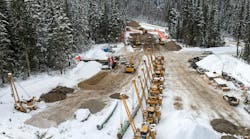New shale plays continue to emerge in North America and elsewhere, but issues related to the environment and land will affect commercial shale development.
This concluding article of a three-part series discusses the emerging plays as well as environmental considerations.
The first part (OGJ, Sept. 28, 2009, p. 39) discussed the seven main shale plays in North America, while the second article (OGJ, Oct. 5, 2009, p. 52) highlighted the strategic and technological lessons learned from a decade of modern shale development with horizontal wells.
Emerging North American shales
Led by the Barnett (5 bcfed), Fayetteville (1.3 bcfed), and fast-rising Haynesville (1.1 bcfed), shale reservoirs currently contribute more than 8 bcfd to North American gas supplies. That is up from just 2 bcfd 5 years ago.
Development continues at a brisk pace within the geologically favored core areas of these proven shale plays, while depressed gas prices, in part due to the shale's success, have drastically slowed drilling in other domestic gas basins.
A couple dozen other new, deep shale plays are at various stages of appraisal (see table). Eastern shale plays have the edge, being generally older, thermally more mature and brittle, and benefitting from stronger wellhead prices (Fig. 1).
Western shales have suffered from the decrease in gas prices and generally lackluster tests but still have tremendous potential (Fig. 2).
Not all of these new shale plays will succeed. Advanced Resources views two plays to be potentially worthy: the Eagle Ford shale in South Texas and the Woodford-Cana shale in western Oklahoma.
Eagle Ford (Texas)
Extending eastward out of the Maverick basin in a narrow belt across South Texas (Fig. 3), the Cretaceous Eagle Ford shale play emerged in 2008 on the heels of the Haynesville success, which it resembles in certain respects.
The Eagle Ford underlies the Austin chalk and is a source rock for the East Texas oil fields. Initial horizontal drilling provides encouragement but the number of wells drilled is insufficient for making a confident prediction on the long-term estimated ultimate recoveries (EURs) and economics.
About 300-ft thick and 11,000-ft deep, the Eagle Ford has a high 4% total organic carbon (TOC) content and a silty texture that is rich in brittle calcareous mineral components. As in the Haynesville, gas-in-place concentrations are high, in the range of 100-200 bcf/sq mile.
The play also has elevated (300° F.) temperatures. The 0.65 psi/ft reservoir pressure gradient, however, is lower than the 0.85 psi/ft gradient in the Haynesville.
Petrohawk Energy Corp. discovered the play by targeting the deeper, more mature areas. Petrohawk has locked up 210,000 acres with low royalties, mainly in La Salle and McMullen counties along the Edwards reef trend, in what appears to be the emerging central core of the play (Fig. 1).
Petrohawk's initial 11 horizontal wells produced at an average 8.9 MMcfed for the initial 24-hr rate, including significant condensate. With a $120 million in capital expenditures committed to the play in 2009, the company has two rigs running and plans to drill 29 operated wells.
In the Maverick basin portion of the play further to the west, Anadarko Petroleum Corp., ConocoPhillips, EOG Resources Inc., Rosetta Resources Inc., St. Mary Land & Exploration Co., and TXCO Resources Inc. have established large positions but are proceeding cautiously with one rig apiece. Tests in horizontal wells in this area have produced from 3 to 6 MMcfed.
On the east and thermally less mature side of the play, Pioneer Natural Resources Co. has accumulated a 250,000-acre leasehold centered on Goliad County. Pioneer's first horizontal well tested 3.7 MMcfed, but flowed gas from only two of its five frac stages.
In all, Eagle Ford shale operators hold about 2 million acres in prospective areas of the play.
Drilling and completion in the Eagle Ford use Haynesville-style techniques. Laterals typically average 3,000-ft in length and the completions involve hydraulic fracturing with 2 million lb of sand proppant pumped in 8-12-stages.
Well costs are slightly less than in the Haynesville, in the range of $6 million/well long-term (all-in).
Petrohawk experimented with 18-stage fracs in two recent wells, reporting flatter production declines, albeit at additional cost.
Woodford-Anadarko (Oklahoma)
Also known as the Cana play, the Woodford shale in the Anadarko basin of western Oklahoma is another emerging shale play with Haynesville-quality potential.
Deeper and more overpressured than its established Arkoma basin cousin and 200 miles to the east, the Anadarko Woodford shale has high (150-200 bcf/sq mile) gas-in-place concentrations. But well costs also are high and companies are still establishing the play.
Advanced Resources' mapping indicates that the geologic sweet spot traverses portions of Dewey, Blaine, and Brady counties, with drilling concentrated in western Canadian County. The Woodford shale is 12,000-15,000 ft deep, thermally mature with Ro >1.1%, and a 0.7 psi/ft overpressured gradient.
Devon Energy Corp. holds 109,000 net acres in the play and estimates its potential at 5 tcfe net but has released no drilling results. The company currently has six rigs running and plans to drill 30 wells in 2009.
Cimerex Energy Co., running three rigs, holds 93,000 net acres in the Anadarko Woodford shale play, also concentrated in western Canadian County.
On the average, the 36 horizontal wells drilled in the play to date employed 3,600-ft laterals and included eight frac-stage stimulations.
The Anadarko and Arkoma Woodford plays are hotbeds for shale technology development. Marathon Oil Corp. is testing interventionless well completions in the Cana that involve perforations outside the casing and isolation valves within the casing (OGJ, Jan. 12, 2009, p. 44).
In the Arkoma, Continental Resources Inc. is testing simultaneous hydraulic fracturing of adjacent horizontal wells, coupled with real-time seismic monitoring.1 Newfield Exploration Co. is testing super 10,000-ft laterals, as well as reverse osmosis with advanced oxidation processes (ozone, ultrasound) to treat frac water flowback.2
Gas recovery and economics in the Cana remain uncertain, but early indications show promise, probably exceeding 5 bcfe EUR for a well costing about $8 million.
Other Eastern US shales
The Lower Huron shale in the West Virginia-Kentucky border region has moved into commercial development, with 200 MMcfd of production. This Devonian-age shale typically is 100 ft thick and 4,000-5,000 ft deep. TOC is reasonably high at about 3.5% but the <1.0% Ro is fairly low as is the 0.3 psi/ft pressure gradient.
Wells employ shorter <3,000-ft laterals, foam fracs, and generally have EURs less than 1 bcf. Companies active in the play include Cabot Oil & Gas Corp., CNX Gas Corp., EQT Corp., Exco Resources Inc., NGAS Resources Inc., Penn Virginia Corp., and Range Resources Corp.
The Ordovician-age Utica shale underlies the Marcellus in Pennsylvania and New York. The Utica resembles the Haynesville in that it is 100-400 ft thick, +15,000-ft deep and overpressured, although TOC levels are only about half as high.
EQT, claiming 200,000 Utica-prospective acres, recently cored the shale in southwestern Pennsylvania at a 13,500-ft depth. Chesapeake Energy Corp. has cored the Utica from 9,000 ft in southeast New York's Chenango County. No operator yet has attempted a deep horizontal Utica well.
The onshore Gulf Coast also is an active area for shale exploration. This area holds the Cambrian-age Conasauga in Alabama, one of the oldest shales to be targeted anywhere, although it is complex structurally and disrupted by extensive thrust faulting.
Dominion Resources Inc. and Energen Corp. have drilled Conasauga test wells but encountered drilling problems and low flow rates.
The Mississippian-age Chattanooga and Floyd (or Neal) shales are stratigraphic equivalents with the Barnett shale. Best developed in central Mississippi, companies have been disappointed with well tests in the Floyd shale in part because the shale is 70% clay-dominated, which inhibits effective fracturing.
Other Western US shales
Western shale plays, already contending with lower wellhead gas prices, frequently are less thermally mature and have a higher content of ductile clays. Production rates have been lower than in many Eastern shale plays, with very limited commercial development.
The key to unlocking the Western shales will be to target their more mature and quartz-rich zones, coupled with improvements in hydraulic fracturing techniques.
Hopes initially were high that the Permian basin Barnett shale of West Texas would match its Fort Worth basin equivalent, but this has not occurred. Initial flow rates generally have been below 1 MMcfd, while wells there are costly due to their greater depth, up to 18,000 ft.
The Bend shale of North Texas's Palo Duro basin was active several years ago until well tests proved disappointing. The Bend has good 2.5-4% TOC but is only marginally mature with a 1% Ro.
The Mancos in the Uinta basin appears to be one of the better western shale plays, with attractive TOC, depth, and thermal maturity. Questar Corp., Gasco Energy Inc., and Bill Barrett Corp. have had good results, achieving EUR's in the 1-5 bcf range.
The Manning Canyon shale in the Uinta is 2,000 ft thick, 7,000-11,000 ft deep, with attractive 1-4% TOC and a 1.2-1.5% Ro. A hard limestone that may provide a frac barrier underlies it. Companies testing the play included Shell Exploration & Production Co., Bill Barrett, and ConocoPhillips.
The Pierre and Mancos shales in the under-drilled Raton basin have fairly shallow 4,000-6,000 ft depths. Pioneer's early wells had EURs less than 1 Bcf, which is subeconomic at current gas prices. El Paso Corp.'s Niobrara shale wells in the Raton basin cost $2-3 million but have modest initial potentials (IPs) of 0.4-1.8 MMcfd.
The Gothic and Hovenweep shales in the Paradox basin are not particularly deep (5,500-7,500 ft) but do have brittle mineralogy with 50-85% quartz-carbonate. Bill Barrett reports spending $4 million for wells that initially produce at about 3 MMcfd.
Questar drilled more than 20 wells in the Baxter shale in the Vermillion basin, Wyoming, but initial flow rates were generally a modest 1 MMcfd. Drilling is on hold.
The Lewis shale at 10,000-15,000 ft depths of the Greater Green River basin is much deeper than its San Juan basin equivalent, has a more mature 1.1-2.0% Ro, and appears to be an excellent target awaiting horizontal shale testing.
Finally, the Monterey and McClure shales in California have rich 5-10% TOC, are highly siliceous, and have vast potential just beginning to be tested. Most areas, however, are thermally immature and oil prone.
Global shale potential
Given the rapid and successful development of seven giant gas shale plays in North America, with their diverse ages and physical characteristics—yet all utilizing similar horizontal wells and large multistage fracs—there appears no reason to doubt the success for developing organic-rich shales in other regions.
Advanced Resources' exploration concept overseas is to follow known shale source rocks into deeper regions where they may have enhanced maturity, gas saturation, pressure gradients, and mechanical brittleness.
Early-stage exploration is under way in Australia, Poland, Sweden, and elsewhere, with little test data yet available.
Europe
Europe has appeal given the age, maturity, and stratigraphic data control of the gas shale targets, not to mention the strong gas markets.
In northern Poland, ConocoPhillips recently teamed with Lane Energy Poland on a million-acre leasehold in the Baltic basin, targeting a 1,500-ft thick Silurian sequence that is silty, calcareous, and high in TOC (OGJ, Sept. 21, 2009, p. 52).
Nearby, BNK Petroleum Inc., also active in the Woodford shale, is evaluating 720,000 acres containing organic-rich Silurian shale that is 500-2,500 ft thick, 7,000-12,500 ft deep, and mature (1.2-2.6% Ro), with moderate 25-63% silica content.
The Jurassic Toarcian shale in the Paris basin covers an area larger than the Barnett shale play. It exists at comparable depths, is rich in organics with a 10% TOC, but is rather thin at 30-100 ft and appears to have low maturity. Eurenergy Resources Corp. and Toreador Resources Corp. are active in the Paris basin.
Shell is testing the Cambrian-Ordovician Alum shale in southern Sweden, which has a 70-200 ft thick oil shale with TOC up to 20%, though relatively immature.
Russia's Dnieper-Donets basin contains Devonian and Carboniferous black shales with a 3-13% TOC, and the Jurassic Bazhenov formation, the principal oil source rock in West Siberia, has 5-9% TOC and reaches a mature 1.3% Ro in its northern extent.
Other operators evaluating gas shales in Europe include ExxonMobil Corp., OMV AG, and StatoilHydro.
Australia
Gas shale drilling has lagged far behind coalbed methane development in Australia but the geologic potential is vast. Santos Ltd., Beach Petroleum Ltd., and Drillsearch Energy Ltd. are evaluating gas shale targets adjacent to producing gas fields in the Cooper basin of western New South Wales.
The thermally mature Cambrian and Ordovician Arthur Creek shale underlies the more remote Southern Georgina basin in central Northern Territory and western Queensland. The Horn Valley siltstone in central Australia's Amadeus basin is an Ordovician source rock that has fed conventional gas fields. This unit is about 150 ft thick and has a thermally mature 1-3% Ro.
Numerous other shales in Australia await testing.
Other areas
Silurian black shales were sources for Algeria's oil fields in the Ghadames-Illizi basins. Morocco's Timahdit and Tarfaya oil shales may have deeper gas shale potential.
In South America, Cretaceous organic-rich shale source rocks are present in both the Maracaibo and Middle Magdalena basins of Colombia and Venezuela. Correlative with the Haynesville shale (Turonian-Cenomanian), this shale is 300 ft thick and has a TOC >10% in places, though Ro appears to be mostly less than 1%.
Clearly, gas shales have promise outside North America, although it will take extensive geologic work and more drilling to locate the sweet spots.
Environmental considerations
Despite the fact that state regulatory oversight over hydraulic fracturing has been effective3 and objective evaluations of reported incidents by environmental groups alleged to be caused by hydraulic fracturing have proven unfounded,4 5 political pressure is calling for more active government oversight of hydraulic fracturing as well as shale gas development (OGJ, July 6, 2009, p. 18).
In some cases, these concerns have slowed or stopped development. For example, in New York, despite extensive activity in neighboring Pennsylvania, development of the Marcellus and Utica shales essentially has been halted pending completion by the state Department of Environmental Conservation (DEC) of a Supplemental Generic Environmental Impact Statement (GEIS) to update a 1992 GEIS.
In February 2009, the DEC released a final scope for the supplemental GEIS.6 The GEIS was required to address water, surface disturbance, and hydraulic fracturing associated with gas shale development. The GEIS would also note noise, visual, and air quality concerns along with the potential for cumulative and community impacts. DEC originally planned for releasing a draft supplemental GEIS for public comment in spring 2009 but has not yet released it.
At the federal level, legislation introduced in Congress would give the US Environmental Protection Agency authority to regulate hydraulic fracturing under the Safe Drinking Water Act, reversing an explicit exemption for fracturing contained in the Energy Policy Act of 2005.
This legislation, the Fracturing Responsibility and Awareness of Chemicals Act, or FRAC Act, also would introduce a new requirement that companies disclose the ingredients used in proprietary fracing fluids.
Given the active development of the massive US natural gas shale resource, the industry needs improved and transparent communication. Industry could model such efforts after the Appalachian Shale Water Conservation and Management Committee (ASWCMC), a consortium of energy companies focused on efficient and responsible use of water associated with shale-gas development in the Appalachian region.7
Moreover, as shale gas development increases, particularly in new areas, and as production grows, a harsher "spotlight" will fall on natural gas.
Efforts to put a more environmentally friendly face on this activity could go a long way to enhance the environmental benefits of natural gas. Such efforts include capturing fugitive methane emissions from shale-gas development and production operations, further reducing the surface impacts of this activity, primarily through the use of multiple-well drilling sites, as well as the use of nontoxic additives in fracture fluids.8
In some areas, large-scale pursuit of hydraulic fracturing will require alternatives for water use and disposal.9 In many cases, operators are taking proactive steps to look for alternative sources of water for fracturing, or in recycling fracture fluids for reuse.10 In some cases, it could be more practical to treat the water to a quality that could be reused for a subsequent hydraulic fracturing job, or other industrial use, than treating to discharge to a surface water body.
References
- Waters, G., et al., "Simultaneous Hydraulic Fracturing of Adjacent Horizontal Wells in the Woodford Shale," Paper No. SPE 119635, SPE Hydraulic Fracturing Technology Conference, The Woodlands, Tex., Jan. 19-21, 2009.
- Horn, A., "Breakthrough Mobile Water Treatment Converts 75% of Fracturing Flowback Fluid to Fresh Water and Lowers CO2 Emissions," Paper No. SPE 121104, SPE Americas E&P Environmental & Safety Conference, San Antonio, Mar. 23-25, 2009.
- Ground Water Protection Council, State Oil and Natural Gas Regulations Designed to Protect Water Resources, Department of Energy (DOE), Office of Fossil Energy, Oil and Natural Gas Program and the National Energy Technology Laboratory (NETL), DOE Award No. DE-FC26-04NT15455), May 2009, from http://www.energyindepth.org/wp-content/uploads/2009/03/oil-and-gas-regulation-report-final-with-cover-5-27-20091.pdf.
- Investigation of the Natural Gas Invasion of Aquifers in Bainbridge Township of Geauga County, Ohio, Ohio Department of Natural Resources, Division of Mineral Resources Management, Sept. 1, 2008, from http://www.dnr.state.oh.us/Portals/11/bainbridge/report.pdf.
- http://cogcc.state.co.us/orders/orders/1v/298.html.
- Final Scope for Draft Supplemental Generic Environmental Impact Statement (DSGEIS) on the Oil, Gas And Solution Mining Regulatory Program Well Permit Issuance for Horizontal Drilling and High-Volume Hydraulic Fracturing to Develop The Marcellus Shale and Other Low Permeability Gas Reservoirs, New York State Department of Environmental Conservation, Feb. 6, 2009, from http://www.dec.ny.gov/energy/47554.html.
- http://www.redorbit.com/news/science/1481546/consortium_of_oil__natural_gas_industry_leaders_form_committee/index.html.
- Kuuskraa, V.A., "Challenges Facing Increased Production and Use of Domestic Natural Gas," Global Energy and Environment Initiative (GEEI), Washington, Sept. 16, 2009.
- Ground Water Use Advisory: Commissioner of Conservation Recommends Wise Water Use Planning in the Haynesville Shale, press release, Louisiana Department of Natural Resources, posted Oct. 16, 2008, on http://dnr.louisiana.gov/sec/execdiv/pubinfo/newsr/2008/1016con-gwater-advisory.ssi.
- Water Use in the Barnett Shale, Railroad Commission of Texas, updated July 30, 2008, from http://www.rrc.state.tx.us/barnettshale/wateruse_barnettshale.php.
The authors
Scott H. Stevens' biography and photo were published in the first installment of this series (OGJ, Sept. 28, 2009, p. 39).Michael Godec ([email protected]) is senior vice-president of Advanced Resources International Inc., Arlington, Va. He is currently a SPE Distinguished Lecturer on the subject "Environmental Performance of the Exploration and Production Industry: Past, Present, and Future," Godec has an MS in technology and human affairs from Washington University in St. Louis, and a BS in chemical engineering from the University of Colorado.
More Oil & Gas Journal Current Issue Articles
More Oil & Gas Journal Archives Issue Articles







